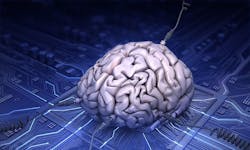Artificial intelligence and new levels of machine learning are aims of IARPA MICrONS program
Officials of the Intelligence Advanced Research Projects Agency (IARPA) in Washington issued a broad agency announcement for the Machine Intelligence from Cortical Networks (MICrONS) program to advance theories of neural computation.
The goal of the IARPA MICrONS program is to create ever more capable neurally derived machine learning algorithms, with an aim to improve the ability to perform complex information processing tasks such as one-shot learning, unsupervised clustering, and scene parsing with near-human-like proficiency.
computer and information technology researchers are intrigued with the human brain as data processor for its ability to separate and categorize signals robustly in the presence of significant noise and non-linear transformations, and then extrapolate from single examples to entire classes of stimuli, IARPA researchers say.
Today's state of the art algorithms, they say, are brittle and do not generalize well -- at least nowhere near the level of the human brain. Today's leading machine-learning algorithms and the human brain still differ significantly in the details of their operation.
The MICrONS program seeks to achieve a quantum leap in machine learning by creating machine learning algorithms that use neurally inspired architectures and mathematical abstractions of the representations, transformations, and learning rules employed by the brain.
Companies ultimately chosen to participate in the MICrONS program will conduct targeted neuroscience experiments that interrogate the operation of mesoscale cortical computing circuits, taking advantage of emerging tools for high-resolution structural and functional brain mapping.
The program is designed to facilitate iterative refinement of algorithms based on a combination of practical, theoretical, and experimental outcomes.
Performers will use their experiences with algorithms design and performance to reveal gaps in their understanding of cortical computation, and will collect neuroscience data to inform new algorithmic implementations that address these limitations.
Related: DARPA launches PPAML artificial intelligence program to move machine learning forward
Ultimately they will devise solutions that can achieve human-like performance on complex information processing tasks with human-like proficiency.
The five-year MICrONS program will have three phases that involve neuroanatomical and neurophysiological studies to improve the understanding of cortical computations underlying sensory information processing. Each phase will lead to a new and increasingly challenging algorithms.
The program's three technical areas are experimental design, theoretical neuroscience, computational neural modeling, machine learning, neurophysiological data collection, and data analysis; neuroanatomical data collection; and reconstruction of cortical circuits from neuroanatomical data and development of information technology systems to store, align, and access neural circuit reconstructions with the associated neurophysiological and neuroanatomical data.
Companies responding may choose to propose to one, two, or all three of the technical areas.
Companies interested should submit responses no later than 13 March 2015 online at https://iarpa-ideas.gov.
Email questions or concerns to Program Manager Jacob Vogelstein at [email protected].
More information is online at https://www.fbo.gov/notices/e056d1851d7bd1a9732717950f598406.
